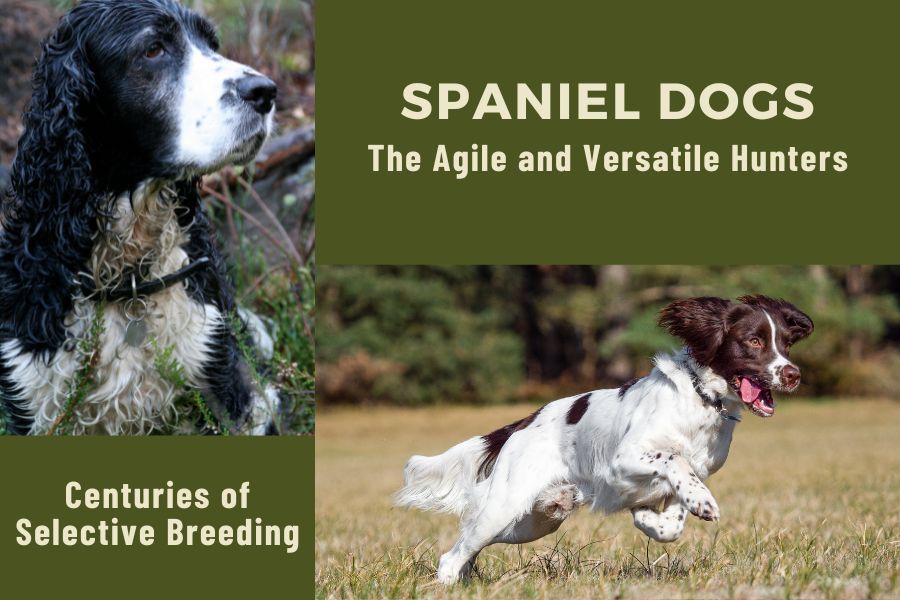Explore the fascinating world of spaniel dogs in our comprehensive guide. Discover their origins, hunting skills, diverse breeds, and essential care tips. Learn why these agile and versatile hunters are cherished by hunting enthusiasts and families alike.
Introduction
Imagine a hunting companion with boundless energy, keen instincts, and unwavering loyalty. That’s the magic of spaniel dogs. Whether they’re flushing game from dense cover or retrieving from water, these agile and versatile hunters never fail to impress.
In this article, we’ll dive deep into the world of spaniel dogs. We’ll uncover their rich history, explore their hunting prowess, and introduce you to various spaniel breeds. You’ll learn why these dogs are not just incredible hunters but also beloved family pets. Plus, we’ll share essential care tips to keep your spaniel happy and healthy.
Did you know that spaniels were bred to work alongside hunters, making them natural-born gundogs? Or that their instinct to find, flush, and fetch game has been honed over centuries? By the end of this guide, you’ll understand what makes spaniels so special and why they remain a top choice for hunters and dog lovers alike.
Spaniel Dogs: Origin and History
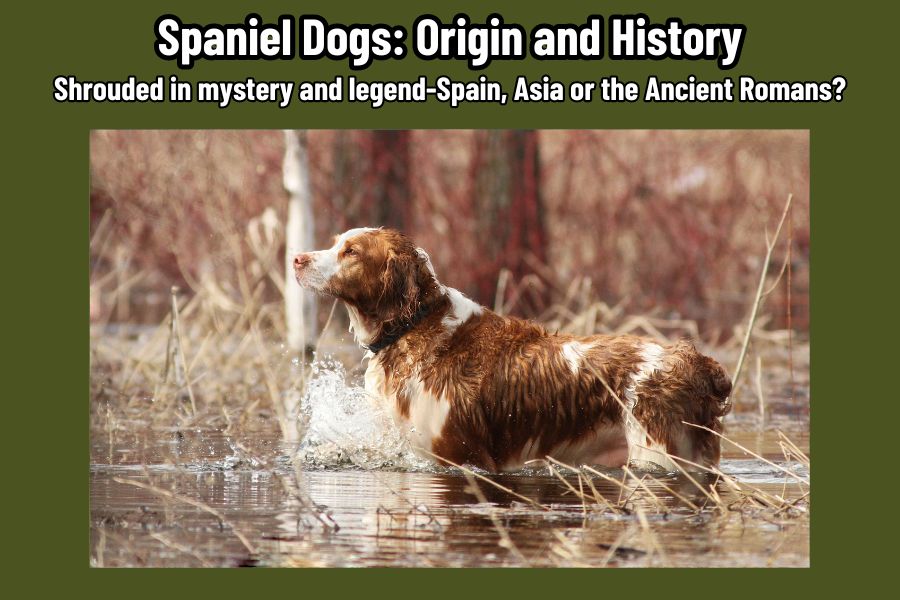
Spaniel dogs have a rich and varied history, one that spans continents and centuries. These dogs, known for their agility and hunting prowess, have been loyal companions to hunters and dog lovers alike. Understanding their origins helps us appreciate their incredible abilities and the traits that make them unique.
Spaniels from Spain, Asia or the Ancient Romans?
The origins of spaniel dogs are shrouded in mystery and legend. Some historians trace their lineage back to Spain, suggesting that the name “spaniel” is derived from the Spanish word “Español.” Others argue that these dogs might have Asian roots, brought to Europe by traders and explorers. There’s even a theory that spaniels were companions to the ancient Romans, who used them for hunting small game. These diverse theories highlight the spaniel’s long-standing relationship with humans and their adaptability across different cultures and environments.
Modern Spaniel Breeds Developed in Britain
The spaniels we know and love today owe much of their development to British breeders. In the 19th century, breeders in Britain began refining and categorizing spaniel breeds based on their hunting skills and physical characteristics. This period saw the emergence of distinct breeds such as the English Springer Spaniel, Cocker Spaniel, and Sussex Spaniel. British breeders focused on enhancing traits that made these dogs excellent hunting companions, like their keen noses, strong swimming abilities, and tireless work ethic. The meticulous breeding practices of the time ensured that modern spaniel breeds are not only skilled hunters but also versatile family pets.
In the Thick of It: Spaniels in the Field
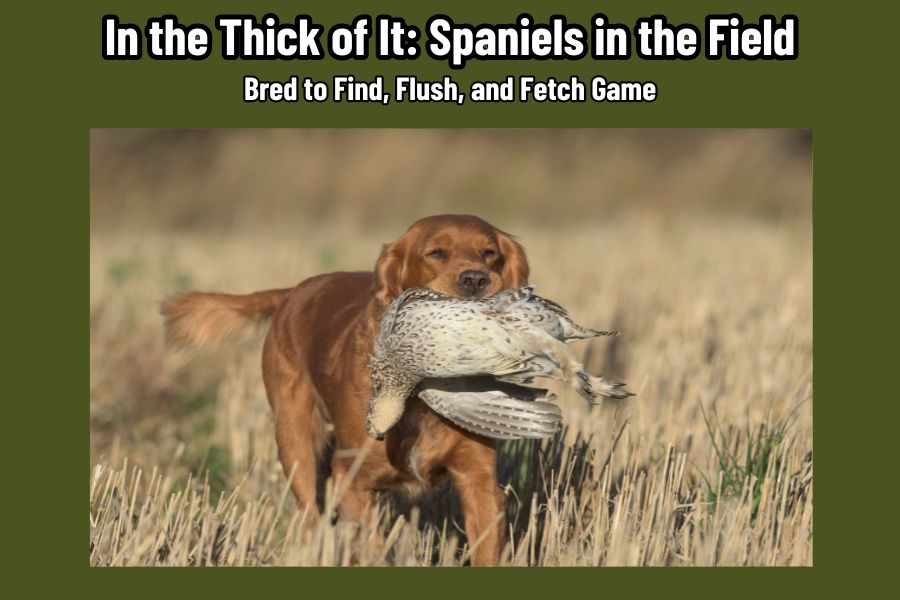
When it comes to fieldwork, spaniel dogs are unmatched in their dedication and skill. Bred specifically for hunting, these dogs thrive in challenging environments, showcasing their abilities with unparalleled precision. Let’s dive into what makes these dogs exceptional hunting companions.
Spaniels: Bred to Find, Flush, and Fetch Game
Spaniel dogs were meticulously bred to perform three critical tasks in the field: find, flush, and fetch game. Imagine a brisk morning in the thick woods, the scent of damp earth in the air. A spaniel darts through the underbrush, its nose working overtime to pick up the scent of hidden game. With a sudden burst of energy, it flushes the game from its hiding spot, sending it into the open. Then, with a graceful leap, the spaniel retrieves the fallen game, its tail wagging proudly.
This instinctual behavior is no accident. Centuries of selective breeding have honed the spaniel’s natural abilities. Their keen sense of smell, agility, and intelligence make them indispensable in the field. Whether it’s upland game birds or waterfowl, spaniels excel in diverse hunting scenarios, proving their worth time and again.
Why Spaniels Make Great Hunting Dogs?
So, what exactly sets spaniels apart from other hunting breeds? For starters, their versatility is second to none. Spaniels can adapt to various hunting environments, from dense forests to open fields and even marshy wetlands. This adaptability ensures they can tackle different types of game with equal efficiency.
Their small to medium size gives them an advantage in navigating tight spaces, and their boundless energy means they can work tirelessly for hours. Spaniels are also incredibly trainable, responding well to commands and displaying a strong desire to please their handlers.
Moreover, spaniels have a unique blend of independence and teamwork. They can work autonomously to locate game, yet they remain closely attuned to their handler’s signals. This balance makes them highly reliable and effective in the field, cementing their reputation as some of the best hunting dogs around.
Spaniel Breeds: Multi-Talented Hunters
Spaniel dogs are known for their exceptional hunting skills and versatility. As gundogs, each breed brings unique traits and abilities to the field, making them invaluable hunting companions. In this section, we’ll explore some of the most notable spaniel breeds, highlighting their origins, physical traits, and behavioral characteristics.
American Water Spaniel
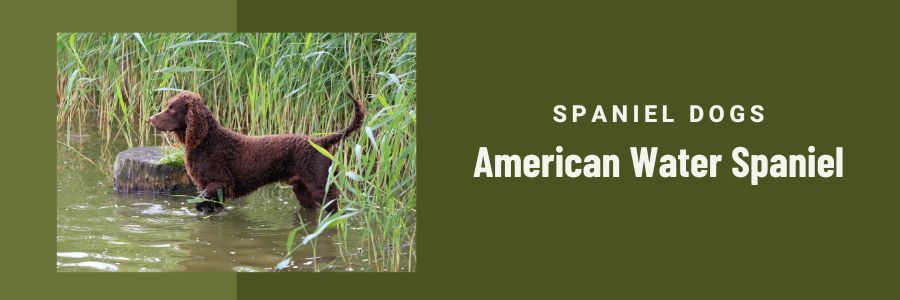
Origin and History
The American Water Spaniel was developed in the United States, primarily in the Midwest, during the 19th century. This breed was created to be an all-around hunting dog, capable of working in both water and upland environments. It remains relatively rare but is highly valued by hunters for its versatility.
Physical Traits
American Water Spaniels are medium-sized dogs, standing 15 to 18 inches tall and weighing between 25 to 45 pounds. They have a dense, curly coat that provides protection from cold water and harsh weather, typically in shades of liver, brown, or chocolate. These spaniels have a sharp sense of smell and a life expectancy of around 10 to 14 years.
Behavioral Traits
With a strong prey drive and exceptional swimming abilities, American Water Spaniels excel in retrieving both on land and in water. They are energetic, intelligent, and highly trainable, making them versatile hunting companions. Their affectionate and loyal nature also makes them great family pets, though they do require regular exercise and mental stimulation to stay happy and healthy.
Boykin Spaniel
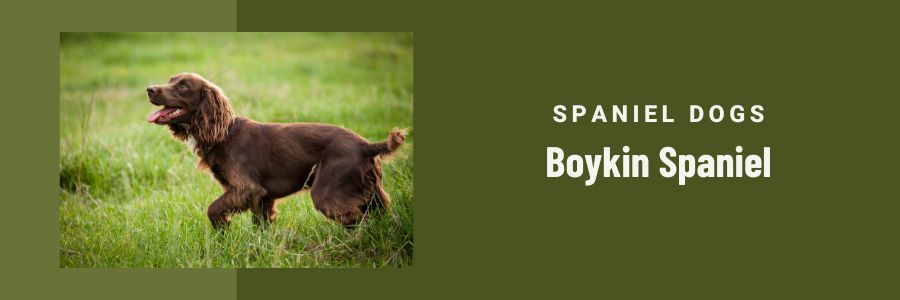
Origin and History
The Boykin Spaniel was developed in South Carolina in the early 20th century. This breed was specifically created to be a versatile hunting dog, capable of working in both upland and waterfowl hunting. The Boykin Spaniel is now the state dog of South Carolina and remains a popular choice among hunters.
Physical Traits
Boykin Spaniels are medium-sized dogs, standing 14 to 18 inches tall and weighing 25 to 40 pounds. They have a medium-length, curly to wavy coat that is typically liver or chocolate in color. Their keen sense of smell and athletic build make them excellent hunters. These spaniels generally have a life expectancy of 10 to 15 years.
Behavioral Traits
Boykin Spaniels are known for their high energy levels, strong prey drive, and versatility in the field. They are highly trainable and eager to work, making them reliable hunting companions. Their friendly and sociable nature also makes them wonderful family pets, as they get along well with children and other animals. They require regular exercise and mental stimulation to stay content.
Brittany Spaniel
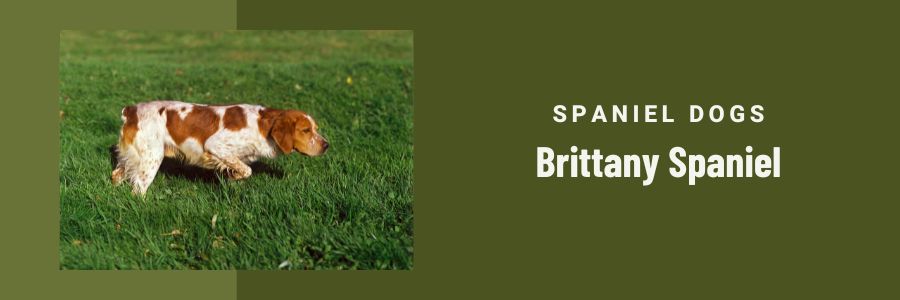
Origin and History
The Brittany Spaniel, also known simply as the Brittany, originated in the Brittany region of France in the 19th century. It was developed by crossing local spaniels with English Setters to create a versatile pointing and retrieving dog. The Brittany is highly regarded for its hunting abilities and has gained popularity worldwide.
Physical Traits
Brittany Spaniels are medium-sized dogs, standing 17.5 to 20.5 inches tall and weighing 30 to 40 pounds. They have a dense, flat or wavy coat that is orange and white or liver and white. Their keen sense of smell and agility make them excellent hunters. Brittany Spaniels typically have a life expectancy of 12 to 14 years.
Behavioral Traits
Brittany Spaniels are energetic, intelligent, and highly trainable, making them versatile hunting dogs. They have a strong prey drive and excel in both pointing and retrieving game. Their affectionate and friendly nature makes them great family pets, and they are known to be good with children. Brittany Spaniels thrive on regular exercise and mental stimulation, which helps them stay happy and healthy.
Clumber Spaniel
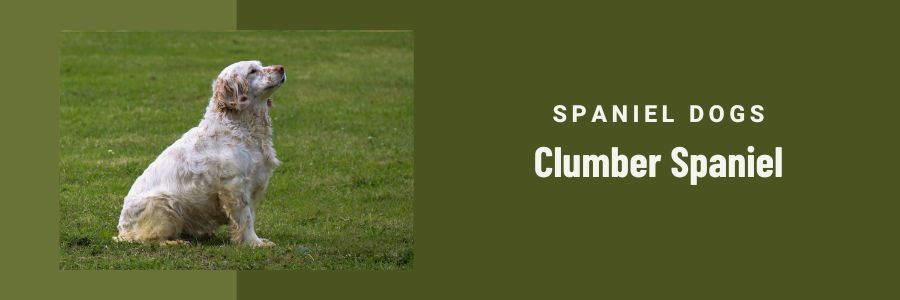
Origin and History
The Clumber Spaniel has its origins in England, dating back to the late 18th century. Named after Clumber Park in Nottinghamshire, these dogs were favored by British aristocracy for their exceptional hunting abilities. Their lineage includes Basset Hounds and Alpine Spaniels, which contributed to their unique appearance and hunting prowess.
Physical Traits
Clumber Spaniels are the largest of the spaniel breeds, standing 17 to 20 inches tall and weighing between 55 to 85 pounds. They have a dense, straight coat that is predominantly white with lemon or orange markings. Known for their strong sense of smell, Clumber Spaniels have broad heads and deep chests, which contribute to their powerful build. Their life expectancy ranges from 10 to 12 years.
Behavioral Traits
Clumber Spaniels are known for being persistent, their steady temperament, and low energy levels compared to other spaniels, making them excellent for slow-paced hunts. They have a moderate prey drive and are highly loyal, often forming strong bonds with their families. Despite their size, they are gentle and can be good family dogs, especially with proper training and socialization. Their trainability and calm demeanor make them versatile companions both in the field and at home.
Cocker Spaniels – American and English
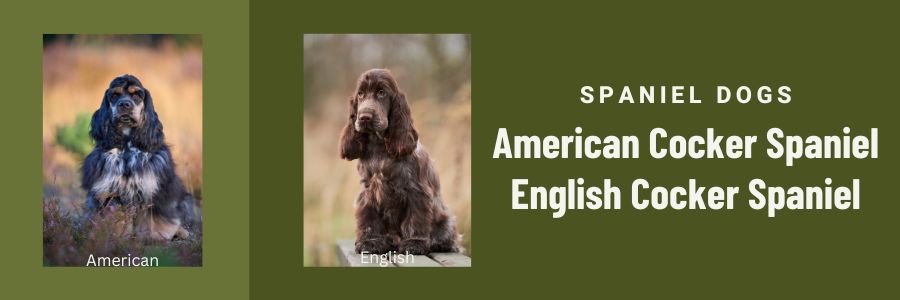
Origin and History
Cocker Spaniels, both English and American, share a common ancestry dating back to Spain. The name “Cocker” is derived from their proficiency in hunting woodcock. The breed was brought to the United Kingdom, where the English Cocker Spaniel was refined for hunting in dense cover.
In the late 19th and early 20th centuries, English Cocker Spaniels were imported to the United States. Over time, American breeders developed a distinct variant known as the American Cocker Spaniel, which was tailored more for show purposes and companionship than strictly for hunting.
Physical Traits
Both English and American Cocker Spaniels are medium-sized dogs, but they exhibit distinct physical differences. English Cocker Spaniels stand about 15 to 17 inches tall, weigh between 26 to 34 pounds, and have a robust, muscular build with slightly longer bodies and legs. Their coats are medium-length, silky, and often wavy, coming in colors like black, liver, red, and parti-colored.
In contrast, American Cocker Spaniels are slightly smaller, standing 13.5 to 15.5 inches tall and weighing 20 to 30 pounds. They have a more rounded skull and shorter muzzle, with a dense, longer coat that can be straight or wavy, available in diverse colors such as black, brown, buff, and parti-colored.
Both types have long, floppy ears prone to infections if not properly maintained, with a life expectancy of 10 to 14 years.
Behavioral Traits
Cocker Spaniels are known for their friendly, affectionate, and playful nature, making them excellent family pets. They are intelligent and eager to please, which makes them relatively easy to train, though they can sometimes exhibit a stubborn streak. These spaniel dogs have a moderate prey drive, reflecting their hunting heritage, and they excel in activities that involve retrieving and agility.
English Cocker Spaniels tend to be more energetic and require ample exercise to stay happy and healthy. They are highly sociable and get along well with children and other pets. American Cocker Spaniels, while still energetic, are often more laid-back and suited for a companion role, thriving on human interaction and affection.
Both breeds are known for their loyalty and bond closely with their families, making them wonderful companions both in the field and at home.
English Springer Spaniel
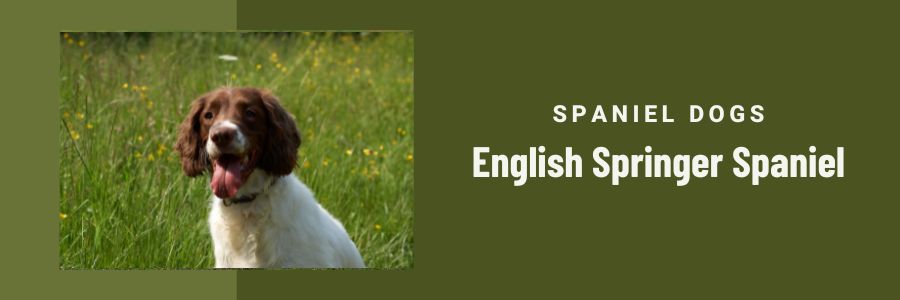
Origin and History
The English Springer Spaniel has a storied history in England, where it was developed as a gun dog to flush and retrieve game. This breed, which dates back to the Renaissance period, was named for its ability to “spring” game into the air.
Physical Traits
English Springer Spaniels are robust and medium-sized, standing 19 to 20 inches tall and weighing between 40 to 50 pounds. They have a double coat that is weather-resistant, with feathering on their legs and chest. Coat colors commonly include black and white, liver and white, and tri-color. They have a life expectancy of 12 to 14 years.
Behavioral Traits
English Springer Spaniels are highly energetic and require plenty of exercise. They possess a strong prey drive and are known for their versatility in the field, excelling in both land and water retrieves. These spaniel dogs are also characterized by their friendly and sociable nature, making them great family pets. They are intelligent and eager to learn, which makes training a rewarding experience.
Field Spaniel
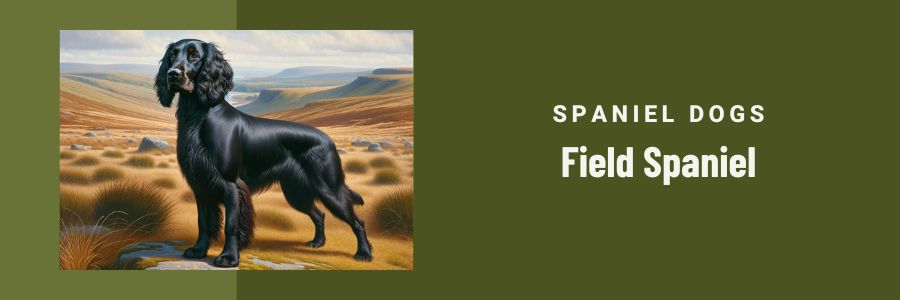
Origin and History
Field Spaniels were developed in England during the 19th century, primarily for retrieving game from both water and land. The breed was created by crossing Cocker Spaniels with larger spaniel breeds to enhance their hunting capabilities.
Physical Traits
Field Spaniels are medium-sized dogs, standing 17 to 18 inches tall and weighing 35 to 50 pounds. They have a dense, water-resistant coat that is typically black, liver, or roan. Their long ears and soulful eyes give them a distinctive look. Field Spaniels generally have a life expectancy of 12 to 14 years.
Behavioral Traits
Field Spaniels are known for their balanced temperament, making them both excellent hunting dogs and family companions. They have a moderate prey drive and are versatile in various hunting environments. These spaniel dogs are intelligent, loyal, and relatively easy to train. Their calm and affectionate nature makes them good with children and other pets, provided they receive adequate exercise and mental stimulation.
Irish Water Spaniel
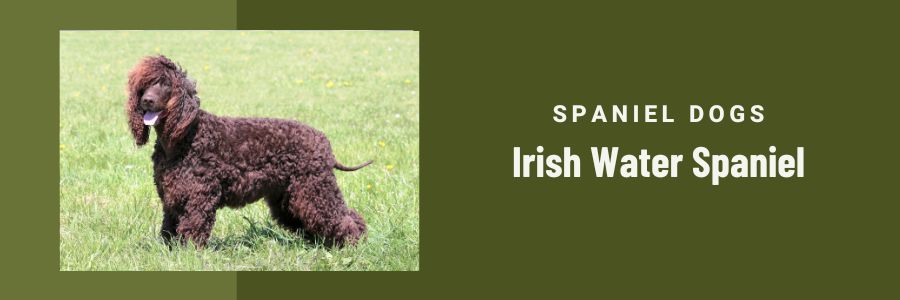
Origin and History
The Irish Water Spaniel is one of the oldest and most distinctive spaniel breeds, originating in Ireland in the 19th century. Known for their unique curly coats and exceptional water retrieving abilities, these dogs were bred to work in waterfowl hunting.
Physical Traits
Irish Water Spaniels are medium to large dogs, standing 21 to 24 inches tall and weighing between 45 to 68 pounds. They have a dense, curly, and water-resistant coat that is typically liver-colored. Their long, rat-like tail and distinctive topknot of curls on their head are unique features. These spaniels have a life expectancy of 10 to 12 years.
Behavioral Traits
Irish Water Spaniels are known for their high energy levels and strong prey drive, particularly in water retrieving. They are highly athletic and versatile, capable of working in various hunting conditions. These spaniel dogs are intelligent and trainable, though they can be independent and require firm, consistent training. Their playful and loyal nature makes them good family pets, provided they receive sufficient exercise and mental stimulation.
Picardy Spaniel
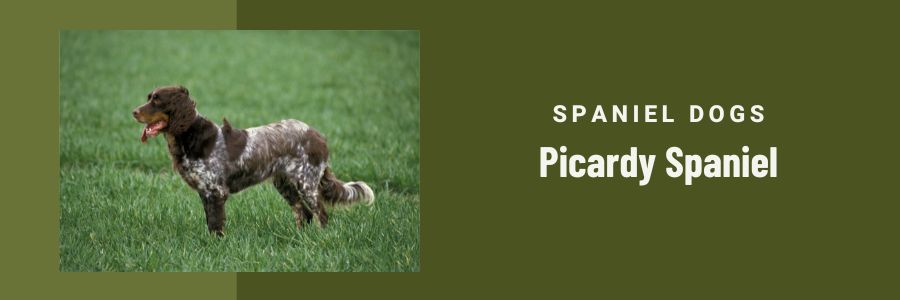
Origin and History
The Picardy Spaniel, originating from the Picardy region in France, is one of the oldest continental spaniel breeds. Developed in the early 19th century, this breed was created to hunt in the marshy and dense cover environments typical of northern France. They are highly regarded for their versatility and endurance in the field.
Physical Traits
Picardy Spaniels are medium to large dogs, standing 22 to 24 inches tall and weighing between 45 to 55 pounds. They have a thick, water-resistant coat that is typically blue-gray with black markings, providing excellent camouflage in natural settings. These dogs are known for their strong sense of smell and sharp eyesight. The average life expectancy of a Picardy Spaniel is around 12 to 14 years.
Behavioral Traits
Known for their calm and steady temperament, Picardy Spaniels are excellent hunting dogs with a strong prey drive and impressive stamina. They are versatile and can adapt to various hunting conditions, from dense forests to open fields. These spaniel dogs are friendly and gentle, making them good family pets. They are intelligent and eager to please, which makes them relatively easy to train and reliable in the field.
Sussex Spaniel
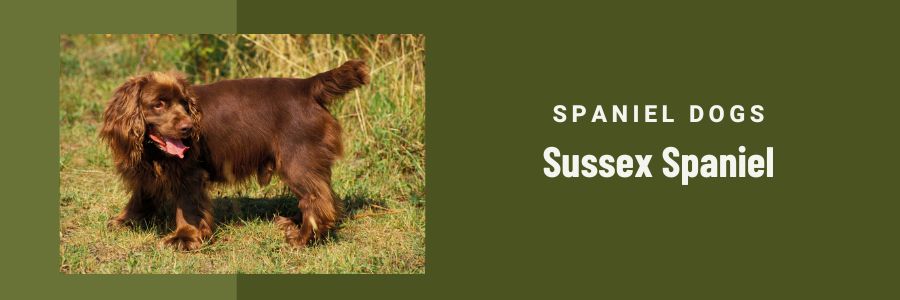
Origin and History
The Sussex Spaniel originated in the Sussex region of England in the early 19th century. This breed was developed primarily for its ability to hunt in dense underbrush and thick cover, making it a favorite among hunters in southern England. The Sussex Spaniel is known for its distinct golden liver color and low, sturdy build.
Physical Traits
Sussex Spaniels are medium-sized dogs, standing 13 to 15 inches tall and weighing between 35 to 45 pounds. They have a long, wavy coat that is uniquely golden liver in color, which helps them blend into their surroundings. Their strong sense of smell and deep bark make them excellent at alerting hunters to game. Sussex Spaniels have a life expectancy of 11 to 13 years.
Behavioral Traits
Sussex Spaniels are known for their steady and deliberate hunting style, which contrasts with the more energetic approach of other spaniels. They have a moderate prey drive and are very loyal and affectionate towards their families. These spaniel dogs are generally calm and good-natured, making them excellent companions. They are trainable, though they may exhibit a stubborn streak, so consistent training is important. Their gentle nature makes them great with children and other pets.
Welsh Springer Spaniel
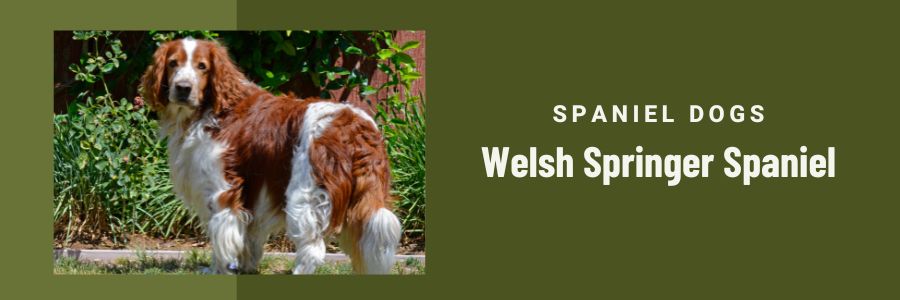
Origin and History
The Welsh Springer Spaniel, a breed with ancient roots, originated in Wales and has been known since at least the 17th century. Initially used for hunting and retrieving game, these dogs were prized for their stamina and ability to work in difficult terrain. The breed gained popularity for its reliable hunting skills and affectionate nature.
Physical Traits
Welsh Springer Spaniels are medium-sized dogs, standing 17 to 19 inches tall and weighing between 35 to 55 pounds. They have a thick, water-resistant coat that is predominantly red and white, which helps them blend into the natural landscape. These dogs are known for their strong sense of smell and excellent agility. Their average life expectancy is 12 to 15 years.
Behavioral Traits
Welsh Springer Spaniels are energetic and possess a strong prey drive, making them excellent hunters. They are known for their athleticism and versatility in various hunting conditions. These spaniel dogs are friendly, affectionate, and highly loyal, making them great family pets. They are intelligent and eager to please, which makes them relatively easy to train.
Other Spaniel Breeds
Spaniels are a diverse group of breeds, known for their versatility and hunting skills. These breeds typically range from small to medium-sized, with shorter legs, medium to long hair, and larger ears. Their unique traits and capabilities have made them popular worldwide. Here are some other notable spaniel dogs we will cover in future posts:
- Dutch Partridge Dog: The Dutch Partridge Dog, also known as Drentsche Patrijshond, is a versatile hunting dog known for its ability to work in various terrains and its friendly, family-oriented nature.
- French Spaniel: The French Spaniel is a robust and versatile hunting dog, prized for its excellent nose and gentle, sociable demeanor.
- German Spaniel: The German Spaniel, or Deutscher Wachtelhund, is a versatile and energetic hunting dog, adept at tracking and retrieving game in both land and water.
- Dutch Spaniel: The Dutch Spaniel, often referred to as the Kooikerhondje, is a small, agile dog originally bred for duck hunting, known for its friendly nature and distinctive appearance.
- Blue Picardy Spaniel: The Blue Picardy Spaniel is a versatile and elegant hunting dog from France, recognized for its striking blue-gray coat and calm, friendly temperament.
- Pont-Audemer Spaniel: The Pont-Audemer Spaniel is a rare French hunting dog, known for its distinctive curly coat and excellent retrieving abilities in water.
- Russian Spaniel: The Russian Spaniel is a compact and hardy hunting dog, popular in Russia for its versatility in flushing and retrieving game.
- Stabyhoun: The Stabyhoun is a rare breed from the Netherlands, valued for its versatility in hunting, as well as its gentle and affectionate nature as a family pet.
- Tweed Water Spaniel: The Tweed Water Spaniel, now extinct, was an early retriever breed from Scotland, known for its excellent swimming abilities and role in developing modern retriever breeds.
- English Water Spaniel: The English Water Spaniel, also extinct, was a proficient water retriever with a curly coat, known for its ability to work in cold and wet conditions.
- Field Trial Springer Spaniel: The Field Trial Springer Spaniel is a high-energy and skilled hunting dog, bred specifically for competitive field trials and known for its excellence in flushing and retrieving game.
- Saint-Usuge Spaniel: The Saint-Usuge Spaniel is a small and versatile French hunting dog, known for its keen nose and affectionate, loyal disposition.
- Polish Hunting Spaniel: The Polish Hunting Spaniel, also known as the Polish Spaniel, is a versatile hunting dog from Poland, valued for its endurance and strong retrieving instincts.
Caring for your Spaniel Hunter
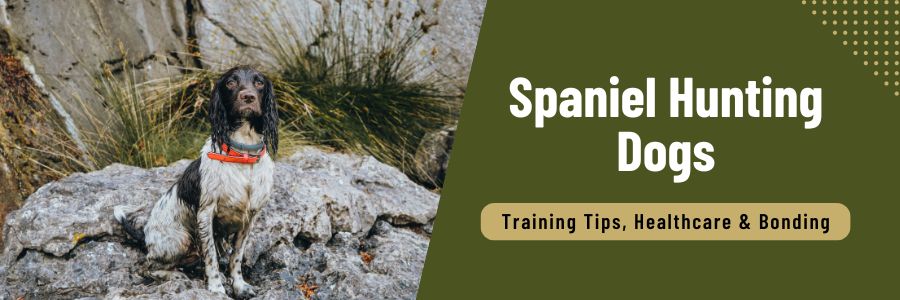
Caring for spaniel dogs goes beyond the basics; it’s about understanding their unique needs as active hunting companions. Proper care includes ongoing training, the right nutrition and health checkups, and fostering a deep bond with your dog.
Training Refresher Tips
Refresher training for spaniel dogs that hunt requires consistency and patience. Start by working on patience and focus, helping your dog control excitement in hunt situations and around other hunting dogs. Trust and obedience are crucial; never allow your dog to hunt without your command. Practice retrieving one bird at a time using bird-like decoys to simulate real hunting scenarios. Train your dog to hold one area at a time, ensuring they remain focused and efficient during hunts. Working on these skills on a regular schedule will enhance your spaniel’s performance and reliability in the field.
Nutritional Guidelines
Spaniel dogs have active lifestyles that demand a balanced and nutrient-rich diet. Ensure their diet includes high-quality protein to support muscle development and repair. Incorporate healthy fats for sustained energy and a shiny coat. Don’t forget carbohydrates for quick energy bursts and fiber for digestive health. Vitamins and minerals are essential to support overall well-being and immune function. Tailoring their nutrition to their activity level helps maintain their stamina and keeps them at peak performance.
Regular Health Check-ups
Regular health check-ups are vital for spaniel dogs, ensuring they stay in top condition. Keep up with vaccinations to protect against common canine diseases. Be aware of spaniel-specific health concerns such as hip dysplasia, ear infections, and eye conditions. Regular vet visits help catch potential issues early, allowing for timely treatment and management. A proactive approach to health care ensures your spaniel remains a robust and ready for the next hunt.
Fostering a Deep Connection in the Field and at Home
The bond between the hunter and the dog is crucial for hunting success. Spend quality time with your spaniel dog both in the field and at home to strengthen this connection. Use positive reinforcement during training sessions to build trust and encourage good behavior. Engage in regular play and activities to help reinforce your bond. A strong relationship built on trust, mutual respect, and companionship will lead to better performance in the field and at home.
Conclusion
In this article, we’ve explored the fascinating world of spaniel dogs, highlighting their agility and versatility as hunters. We delved into their rich history, discussed the unique traits of various spaniel breeds, and provided essential tips for training, nutrition, and health care. By understanding and caring for your spaniel, you can ensure they remain exceptional hunting companions and loyal family pets. With the right training, care and bonding, your spaniel will continue to impress and inspire for years to come.
FAQs: Spaniel Dogs
Below are some common questions and answers about spaniel dogs:
What makes a dog a spaniel?
Spaniel Dogs Answer:
A spaniel is characterized by its medium size, longer ears, and often wavy or curly coat. Historically bred for hunting, spaniels are known for their ability to find, flush, and retrieve game. Their keen sense of smell, agility, and friendly temperament distinguish them from other breeds.
Why do Spaniels make good hunting dogs?
Spaniel Dogs Answer:
Spaniels make excellent hunting dogs due to their versatility, keen senses, and natural hunting instincts. They are bred to be proficient in both upland and waterfowl hunting, displaying exceptional skills in flushing and retrieving game. Their energy, intelligence, and eagerness to please make them reliable and effective companions in the field.
Which spaniel is best for hunting?
Spaniel Dogs Answer:
The best spaniel for hunting depends on the specific needs of the hunter. English Springer Spaniels are highly regarded for their versatility and endurance in various hunting environments. Brittany Spaniels are excellent for pointing and retrieving, while American Water Spaniels excel in waterfowl hunting. Each breed offers unique strengths suited to different types of hunting.
Are Spaniels easy to train?
Spaniel Dogs Answer:
Yes, spaniels are generally easy to train due to their intelligence and eagerness to please. They respond well to positive reinforcement and consistent training methods. However, some breeds may exhibit a stubborn streak, so patience and persistence are key to successful training.
Are Spaniels good family dogs?
Spaniel Dogs Answer:
Spaniels make great family dogs due to their friendly and affectionate nature. They are known for being good with children and other pets, provided they are properly socialized. Their loyal and gentle temperament makes them wonderful companions both at home and in the field.
How often should I train my spaniel hunting dog?
Spaniel Dogs Answer:
Regular training is essential to keep a spaniel hunting dog sharp and obedient. Ideally, training sessions should be conducted several times a week, focusing on both basic commands and specific hunting skills. Consistent, ongoing training helps maintain their performance and ensures they remain well-behaved and effective in hunting situations.
Resources: Spaniel Dogs
These resources provide valuable information for anyone interested in spaniel dogs, from training and care to understanding their unique traits and history.
SPECIAL NOTE: “The information provided in this post is based on research using the Resource links listed below. While we try to keep the information for this post current, there are no representations expressed or implied, about the completeness, or accuracy of the information provided. Therefore all hunters should always verify current information from these resources along with other local and federal publications”.
Online Resources
AKC – American Kennel Club
TKC – The Kennel Club
UKC – United Kennel Club
CKC – Canadian Kennel Club
Best Books
- “Spaniels: Their Training, Working & Management” by R. W. Morton
- “The Complete Guide to English Springer Spaniels” by Joanna de Klerk
- “The Cocker Spaniel Handbook” by Linda Whitwam
- “Training and Hunting Bird Dogs: How to Become a Professional Dog Trainer” by Scott Linden
- “The Field Spaniel: A Complete and Comprehensive Owner’s Guide” by Dog Care Professionals

